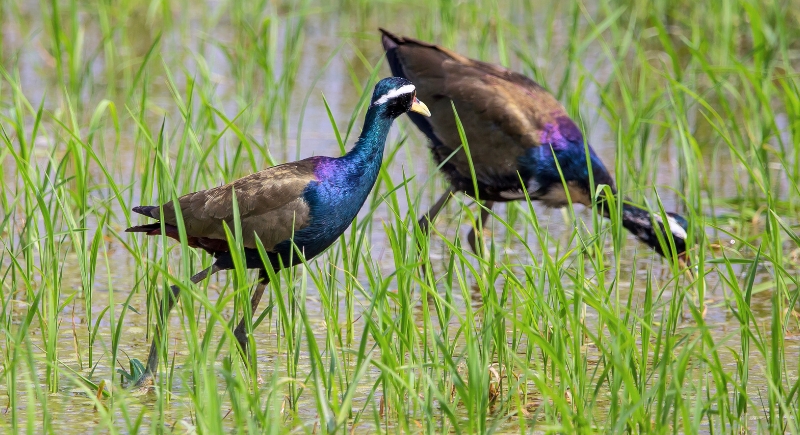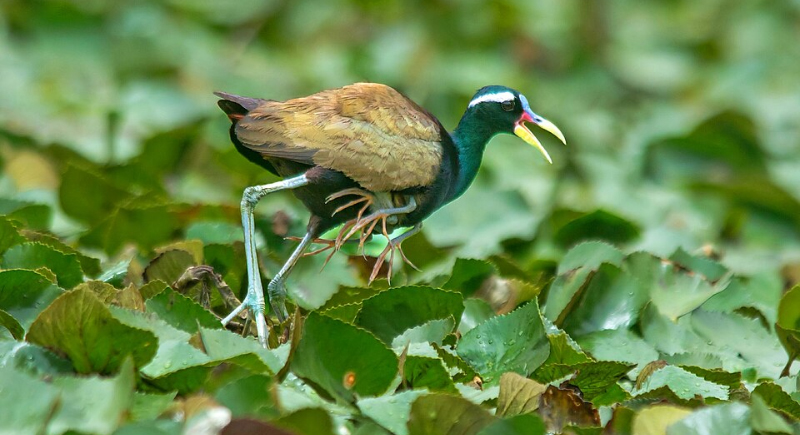Why Does the Male Jacana Do All the Parenting Work?
Jacanas are instantly recognizable in the wetlands. Their toes stretch so wide they can walk across floating pads without breaking the surface, each step slow and deliberate, as if the water itself holds them up. Watching them pick their way across a marsh is unlike seeing any other wading bird.
But it isn’t just their appearance that stands out. Their family system runs on a set of rules that few other birds follow. The balance between male and female takes an unexpected turn, and what looks like a familiar story of courtship and care plays out in a way that challenges the usual script of bird life.
Female Jacanas Dominate Territories and Collect Harems

Image via iStockphoto/photonewman
Female jacanas rule the wetlands with size and aggression, often weighing up to 60 percent more than males. That physical edge lets them seize large territories, which they defend against rivals.
Within her space, a dominant female may oversee up to five males, each responsible for his own nest. She mates with every one of them, deposits clutches, and then defends the area against challengers. Rivalries can be brutal, with incoming females sometimes destroying eggs or chicks to take over males.
Studies in Panama revealed that this female-led system creates constant competition among dominant birds while leaving males locked into full parental care without alternatives.
Male Jacanas Build Nests and Care for Eggs
Consequently, the males take on every step of nesting and incubation. They construct small rafts of leaves and stems that float among lily pads. Instead of sitting directly on eggs, a male presses them against bare patches of skin beneath his wings to provide warmth and moisture control.
If flooding threatens, he can roll eggs across lily pads to a safer spot or carry them tucked in. This level of attentiveness is essential because wetlands face heavy rains and shifting waters. Researchers note that incubation can last nearly a month. During that time, the males remain constantly alert, guard against hunters, and make adjustments to keep the eggs dry.
When chicks hatch, they climb under his wings for warmth or cling to him as he moves, typically appearing as extra dangling legs beneath his feathers. The male’s careful effort ensures some chicks are able to make it to adulthood in unpredictable environments.
Evolution Favors Female Egg Production
High predation rates explain why jacanas evolved such an unusual system. Eggs and chicks are frequently eaten by crocodiles, turtles, snakes, and predatory birds. To counter these losses, females maximize egg production instead of investing in individual nests. Freed from parental duties, they behave like what scientists call “egg-making machines,” and produce clutches in rapid succession across multiple males’ nests.
Males, by contrast, specialize in safeguarding and raising whatever eggs they are given. This division of labor increases the chances that at least some young mature. According to experts studying wattled jacanas, females averaged dozens of copulations per clutch, sometimes over sixty, to secure fertilization and maintain bonds with males.
The female’s focus on reproduction rather than care may seem harsh, but in an environment where most nests fail, her strategy spreads genetic material widely. For the species, this system balances extreme loss with prolific production and ensures that enough young survive to adulthood for populations to remain stable.
Fathers Protect Chicks Against Many Threats

Image via Wikimedia Commons/Vedant Raju Kasambe
After hatching, chicks walk, dive, and swim within hours, but they remain under their father’s watch for up to seventy days. During this time, the male teaches them to forage for insects, snails, and larvae, and keeps them safe against threats. If danger approaches, he calls the chicks, crouches, and hides them under the feathers before moving them to safety.
To an observer, it looks like the bird suddenly sprouts extra legs, which are actually the chicks’ feet sticking out. In more serious threats, chicks dive underwater and breathe through the tips of their bills until the father signals the all clear.
Despite these tactics, survival rates remain low, with some populations seeing only a small fraction of chicks reach adulthood. Still, paternal care dramatically improves their chances. By devoting weeks of energy to saving and guiding the young, males act as the first and often only line of defense in predator-filled wetlands.